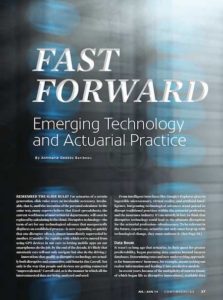
The American Academy of Actuaries has just released their July / August edition of Contingencies Magazine, with an article about the impact of technology on actuarial practice.
It’s a great article: with quotes such as this, you know its presenting some challenging ideas as to how insurance industry, and the actuarial profession that assesses risk, is in for wild ride:
“From intelligent interfaces like Google’s Explorer glass to ingestible microsensors, virtual reality, and artificial intelligence, burgeoning technological advances stand poised to disrupt traditional practices within the actuarial profession and the insurance industry.”
I’m quoted liberally throughout the article.You can click the image to access the PDF.
From the intro to the article:
REMEMBER THE SLIDE RULE? For actuaries of a certain generation, slide rules were an invaluable accessory. Invaluable, that is, until the invention of the personal calculator. In the same way, many experts believe that Excel spreadsheets, the current workhorse of most actuarial departments, will soon be replaced by calculating in the cloud. Disruptive technology—the term of art for any technological advance that unexpectedly displaces an established process—is now expanding so quickly that one disrupter often is almost immediately superseded by another. (Consider the rapidity with which we’ve moved from using GPS devices in our cars to letting mobile apps on our smartphones do the job. By the end of the decade, it’s likely that automatic cars will not only navigate but also do the driving.)
Innovations that qualify as disruptive technology are actual ly both disruptive and connective, said futurist Jim Carroll. Not only is the way that people and devices are getting connected “unprecedented,” Carroll said, so is the manner in which all the interconnected data are being analyzed and used.
This goes to one of the main points that I raise with clients: control of innovation in every single industry is shifting to technology companies, and the pace of innovation is accelerating to that of Silicon Valley as a result. Every industry is coming to be ruled by the reality of Moore’s Law! This is providing for a lot of fascinating change and disruption!
I also offer some comments on might happen with life insurance policies as we go forward
Using more personalized information will lead to what Carroll calls “performance-oriented insurance,” which he defined as coverage in which the risk will be accurately understood. “And if your measurable activities reduce or eliminate any risk, you will be rewarded through a rebate or reduction in insurance cost,” Carroll explained—something that is already happening with one of Progressive’s auto-insurance products.
“There will be an emergence of insurance companies forthose who are willing to give up their privacy, while other insurers might write coverage for those who want to maintain their privacy,” Carroll said. “It is going to change business models.” The connectivity goes further when real-time vitals are sent not just to the doctor but also to an insurance com- pany that’s considering pricing, Carroll said.
It’s a good read, and worth your time. Read the article here.




GET IN TOUCH
Jim's Facebook page
You'll find Jim's latest videos on Youtube
Mastodon. What's on Jim's mind? Check his feed!
LinkedIn - reach out to Jim for a professional connection!
Flickr! Get inspired! A massive archive of all of Jim's daily inspirational quotes!
Instagram - the home for Jim's motivational mind!